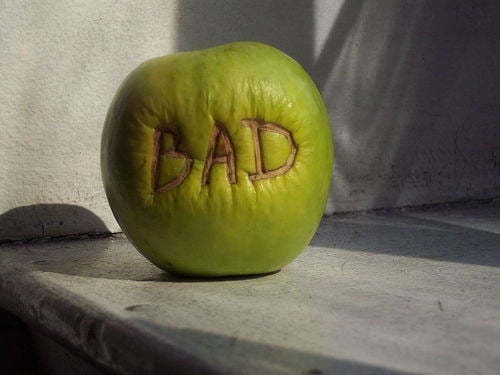Apple cant compete, decides to sue HTC for Patent Infringement
4 min. read
Published on
Read our disclosure page to find out how can you help MSPoweruser sustain the editorial team Read more

Apple today filed a lawsuit against HTC for infringing on 20 Apple patents related to the iPhone’s user interface, underlying architecture and hardware. The lawsuit was filed concurrently with the U.S. International Trade Commission (ITC) and in U.S. District Court in Delaware.
“We can sit by and watch competitors steal our patented inventions, or we can do something about it. We’ve decided to do something about it,†complained Steve Jobs, Apple’s CEO. “We think competition is healthy, but competitors should create their own original technology, not steal ours.†he went on to whine.
Apple claimed to have reinvented the mobile phone in 2007 with its 2G iPhone®, which then lacked cut and paste, and in 2008 discovered native applications were better than web pages, which they were pushing at the time. Over 40 million iPhones using native applications have now been sold.
Apple ignited the personal computer revolution in the 1970s with the Apple II and reinvented the personal computer in the 1980s with the Macintosh but now only hold around 3% of the computer market world wide.
Of note is that any Windows Mobile licensee has automatic patent protection for any Microsoft technology included in the device, which may mean the patents either cover HTC implementations of other technology, HTC’s work on Android or that Microsoft will soon join HTC in the dock.
Read less at Apple here.
Update: The patents in question.
- The ‘331 Patent, entitled "Time-Based, Non-Constant Translation Of User Interface Objects Between States," was duly and legally issued on April 22, 2008 by the United States Patent and Trademark Office.
- The ‘949 Patent, entitled "Touch Screen Device, Method, And Graphical User Interface For Determining Commands By Applying Heuristics," was duly and legally issued on January 20, 2009 by the United States Patent and Trademark Office. A copy of the ‘949 Patent is attached hereto as Exhibit B.
- The ‘849 Patent, entitled "Unlocking A Device By Performing Gestures On An Unlock Image," was duly and legally issued on February 2, 2010 by the United States Patent and Trademark Office. A copy of the ‘849 Patent is attached hereto as Exhibit C.
- The ‘381 Patent, entitled "List Scrolling And Document Translation, Scaling, And Rotation On A Touch-Screen Display," was duly and legally issued on December 23, 2008 by the United States Patent and Trademark Office. A copy of the ‘381 Patent is attached hereto as Exhibit D.
- The ‘726 Patent, entitled "System And Method For Managing Power Conditions Within A Digital Camera Device," was duly and legally issued on July 6, 1999 by the United States Patent and Trademark Office. A copy of the ‘726 Patent is attached hereto as Exhibit E.
- The ‘076 Patent, entitled "Automated Response To And Sensing Of User Activity In Portable Devices," was duly and legally issued on December 15, 2009 by the United States Patent and Trademark Office. A copy of the ‘076 Patent is attached hereto as Exhibit F.
- The ‘105 Patent, entitled "GMSK Signal Processors For Improved Communications Capacity And Quality," was duly and legally issued on December 8, 1998 by the United States Patent and Trademark Office. A copy of the ‘105 Patent is attached hereto as Exhibit G.
- The ‘453 Patent, entitled "Conserving Power By Reducing Voltage Supplied To An Instruction-Processing Portion Of A Processor," was duly and legally issued on June 3, 2008 by the United States Patent and Trademark Office. A copy of the ‘453 Patent is attached hereto as Exhibit H.
- The ‘599 Patent, entitled "Object-Oriented Graphic System," was duly and legally issued on October 3, 1995 by the United States Patent and Trademark Office. A copy of the ‘599 Patent is attached hereto as Exhibit I.
- The ‘354 Patent, entitled "Object-Oriented Event Notification System With Listener Registration Of Both Interests And Methods," was duly and legally issued on July 23, 2002 by the United States Patent and Trademark Office. A copy of the ‘354 Patent is attached hereto as Exhibit J.
Most of these patents, as expected, are user interface related, and while not native to Windows Mobile 6.1, are now nearly standard in Windows Mobile 6.5 and Windows Phone 7. This should get interesting…
Update 2:
Engadget further reports that Apple specifically complained to the ITC about the Nexus One, Touch Pro, Touch Diamond, Touch Pro2, Tilt II, Pure, Imagio, Dream / G1, myTouch 3G, Hero, HD2, and Droid Eris, but when it came to Windows Mobile devices the complaints are all hardware based, due to the inclusion of DSP chips. The Android devices appear to be suffering the full brunt of the complaint, meaning their UI implementation is in question.
As mentioned earlier, Windows Mobile handsets come with indemnity for the Microsoft technology implemented in them, which likely had a protective effect on those HTC handsets.
Via Engadget.com








